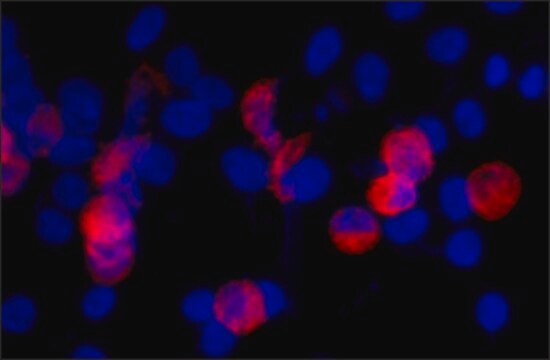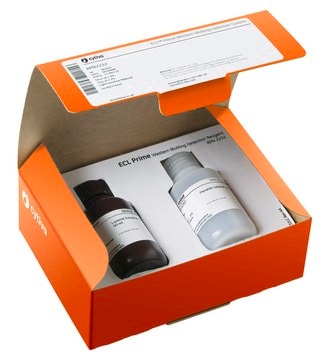16-213
Anti-Myc Tag Antibody, clone 4A6, HRP conjugate
clone 4A6, Upstate®, from mouse
Synonym(s):
Transcription factor p64, avian myelocytomatosis viral oncogene homolog, myc proto-oncogene protein, v-myc avian myelocytomatosis viral oncogene homolog, v-myc myelocytomatosis viral oncogene homolog (avian)
About This Item
biological source
mouse
Quality Level
conjugate
peroxidase conjugate
antibody form
purified immunoglobulin
antibody product type
primary antibodies
clone
4A6, monoclonal
species reactivity
human
manufacturer/tradename
Upstate®
technique(s)
western blot: suitable
NCBI accession no.
UniProt accession no.
shipped in
dry ice
target post-translational modification
unmodified
Gene Information
human ... MYC(4609)
General description
Specificity: Recognizes and is specific for recombinant proteins containing the Myc epitope tag (EQKLISEEDL) in a variety of sequence contexts. Also recognizes human Myc.
Species Cross-reactivity: Human, others not tested
Ig Type: IgG
Host: Mouse
Molecular Weight: Varies depending upon the protein which is tagged
Specificity
Immunogen
Application
Epitope Tags & General Use
Epitope Tags
Quality
Western Blot Analysis:
1:500 dilution of this antibody detected myc-PP2A on 10 µg of Myc-PP2A A subunit transfected NIH/3T3 lysates.
Target description
Physical form
Storage and Stability
Analysis Note
Positive control for human Myc: Widespread expression including A431 cell lysate, ovarian cancer cell lysate, or breast carcinoma tissue. Myc fusion protein expressed in cells.
Other Notes
Legal Information
Disclaimer
Not finding the right product?
Try our Product Selector Tool.
Signal Word
Warning
Hazard Statements
Precautionary Statements
Hazard Classifications
Aquatic Chronic 2 - Skin Sens. 1
Storage Class Code
10 - Combustible liquids
WGK
WGK 3
Flash Point(F)
390.2 °F - closed cup - Information refers to the main ingredient.
Flash Point(C)
199 °C - closed cup - Information refers to the main ingredient.
Certificates of Analysis (COA)
Search for Certificates of Analysis (COA) by entering the products Lot/Batch Number. Lot and Batch Numbers can be found on a product’s label following the words ‘Lot’ or ‘Batch’.
Already Own This Product?
Find documentation for the products that you have recently purchased in the Document Library.
Customers Also Viewed
Our team of scientists has experience in all areas of research including Life Science, Material Science, Chemical Synthesis, Chromatography, Analytical and many others.
Contact Technical Service







